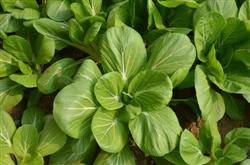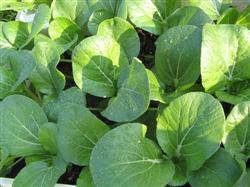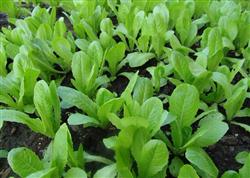How to grow cabbage in summer

How to grow Chinese cabbage in high temperature in summer? Please introduce the methods of planting pakchoi in summer, you can refer to the following methods: 1. Select heat-resistant, disease-resistant and commercial cabbage varieties that are suitable for local summer high-temperature planting and consumption habits. There are mainly heat-resistant green stem vegetables, such as early maturity No. 5, 'Huaguan', 'Xiamei', 'Lion run' and so on. 2. Pakchoi in soil treatment has higher requirements for soil. While pulling seedlings and clearing the garden in time, if waterlogging and serious diseases occur at the end of the harvest of the previous crops, lime and fungal agents should be used for soil disinfection. If the secondary salinization of the soil in the greenhouse is serious, use flood to wash salt, build a soil encirclement around the greenhouse before irrigation, make it higher than the soil surface, and make the water immerse the soil surface during irrigation. If the greenhouse film is not removed, the whole greenhouse can be sealed for 7 days. The high temperature in the greenhouse can be used to kill some bacteria in the soil. If conditions permit, calcium cyanide (lime nitrogen) can be combined with disinfection, and the effect will be better. After soaking the soil for a few hours, the water is discharged and repeated several times, which can desalinate 50% of the surface soil. In order to change the clayey paddy soil into vegetable land, soil improvement must be carried out first. 1-5 months before planting leafy vegetables, pig manure, duck manure, chicken manure and other mature organic fertilizers or commercial organic fertilizers that meet the pollution-free standards were selected and applied evenly into the soil layer according to the use rate of 5000 kg per mu. 3. Soil preparation, application of basic fertilizer, sand loam and loam soil with net mulching are the most suitable, and they should be close to the water source for irrigation. 1000-1500 kg of fully mature barnyard manure and compost or 45-75 kg of special fertilizer for vegetables are applied per mu, and ridges are made after land preparation, with a width of 1.2-1.5 meters. After the former cultivation in the greenhouse, do not dismantle the shed, leave the top film, remove the skirt, and cover the position of the original skirt with anti-insect net; if conditions permit, you can also use anti-insect net to cover cultivation in the whole shed. The greenhouse covered with anti-insect net group film should reduce the coverage area of top film as far as possible, increase the area of anti-insect net, increase the ventilation in the greenhouse, prevent the shrinkage of pakchoi leaves caused by high temperature in the greenhouse, and affect the quality of pakchoi. Or cover the sunshade net on the roof to make the cabbage grow normally. 4. pour enough bottom water before sowing, and strip direct seeding or sowing is often used. The sowing rate per mu is 500 to 1000 grams. Cover with a thin layer of straw or sunshade net after sowing. Generally do not water before emergence, such as dry weather, sooner or later spray water and moisturize the mulch such as straw or sunshade net. 5. Field management (1) seedlings emerged 3 days after weeding and sowing, the mulch was removed in time after emergence, and the seedlings were planted for the first time when a true leaf was grown. Early rather than late, it is appropriate to go to the seedlings that are too dense from time to time. When 4 true leaves are grown, the second seedling will be carried out, and the weak and diseased seedlings will be removed. At the same time, combined with the market situation, the seedlings will begin to appear on the market. At the same time, pull out the weeds. (2) Fertilizer and water management after watering the seedlings once or twice a day, small water should be watered frequently, horse water should be watered to avoid flooding and noon watering in sunny days, and micro-irrigation facilities can also be used for sprinkler irrigation and fertilization. Generally, topdressing is the first time in 3 leaves and 1 heart, and the time, times and amount of topdressing are determined according to the soil fertility and the growth potential of vegetable seedlings. Generally, 10 kg urea is applied per mu and spread evenly on the border surface. (3) disaster weather management during the rainy season and in case of typhoon and rainstorm, the ditch and drainage should be cleared in time to prevent the stagnant water in the shed, resulting in the death of Chinese cabbage retting root. When a typhoon comes, we should do a good job in preventing Taiwan and resisting Taiwan according to the wind level forecast of the meteorological department, and uncover the film and protect the shed if necessary. In the hot and dry weather in summer, we should water and run horse water sooner or later, on the one hand, it can fully meet the water demand for the growth of Chinese cabbage, on the other hand, it can adjust the microclimate in the greenhouse and reduce the temperature of the greenhouse. (4) due to the high temperature in summer and excessive Rain Water, pakchoi often die seedlings, or retting roots, or soft rot, so the field must be drained smoothly to prevent stagnant water in the field, and the diseased plants should be pulled out in time for the occurrence of soft rot in the field. and use 1000-fold solution of 8% Ningnanmycin or 20% thiadimefon or 47% Chunlemycin. Copper oxychloride (Jiarinong) was sprayed with 750 times solution or irrigated with root, once every 5-7 days. The main pests of pakchoi in summer are aphids, cabbage insects, Plutella xylostella, whitefly and so on. Due to the use of anti-insect net plus film cover or full anti-insect net cover, the invasion of foreign insect sources can be isolated, and insecticides can be applied according to the actual occurrence of insect pests at the seedling stage. Pieris rapae, Plutella xylostella, Spodoptera litura and Spodoptera exigua can be controlled with 1 billion PIB/ml Aolu No. 1 1000 times or 5% chlorobenzamide SC; aphids and whiteflies can be trapped and killed by hanging yellow board or with 70% imidacloprid or 10% imidacloprid or 20% acetamiprid SP. In general, pakchoi cultivated with anti-insect net plus film or full-scale anti-insect net is only controlled once with pesticides according to the actual situation at the seedling stage, or no pesticides are used. 6, harvest high temperature season precocious No. 5 20murl 25 days can be harvested, 'Huaguan', 'Xiamei', 'Lion run' and other heat-resistant green stem vegetables can be harvested in 45-60 days, long stem white can be harvested in 45 days, generally after 50 days, the yield of long stem white will not increase again, so it should be harvested in time, the yield of pakchoi is generally about 2000 kg per mu. Click to get more cabbage planting techniques click to get more vegetable planting techniques
- Prev

How to grow Chinese cabbage in summer and autumn?
How to grow Chinese cabbage in summer and autumn? Please give a detailed introduction to the planting methods of high temperature in summer and autumn, more rainstorms and heavy diseases and insect pests. Using rain shelter and pest control facilities to produce pakchoi is light, which is conducive to pollution-free production; the yield is high, generally producing 1900 kg of large vegetables per mu, which is better than being covered with an anti-pest net alone.
- Next

How to grow cabbage in summer?
How to grow cabbage in summer? Please give a detailed introduction to the method of summer cabbage can refer to the following methods of planting: 1, variety selection. Choose high temperature resistance, disease resistance, compact core of fine varieties, such as Xiayou No. 2, Xiayou No. 3, Xiayang, etc. 2. Apply sufficient base fertilizer and sow at appropriate time. After the harvest, the wheat was harvested and the wheat was harvested.
Related
- Where is it suitable to grow horseradish in China? it is expected to see the middle altitude horseradish in Alishan.
- How to prevent tomato virus disease reasonably? (Control methods included)
- Many people like to plant towel gourd on the balcony. What are the main points of this method and management?
- What crops can chili peppers be mixed with?
- Fertilization techniques and matters needing attention in Tomato
- What are the grafting techniques for peach seedlings in spring?
- Harm and control methods of root swelling disease of Chinese cabbage
- What are the pests of sweet potatoes? How to prevent and cure it?
- Symptoms, causes and Control methods of navel Rot in Tomato
- The cause of "Cucumber rotten bibcock" in Farmers' planting Cucumber and its Control Plan

